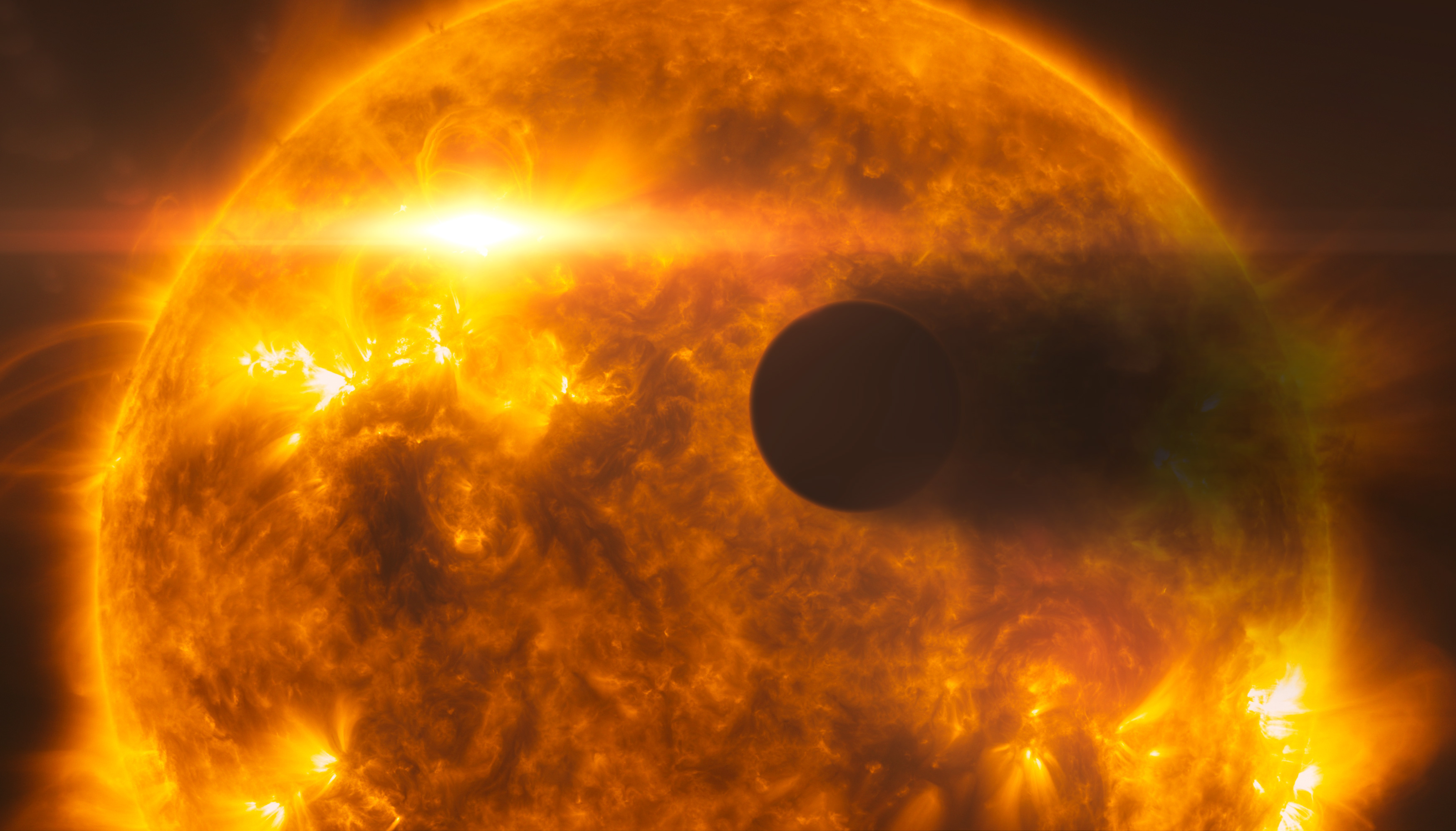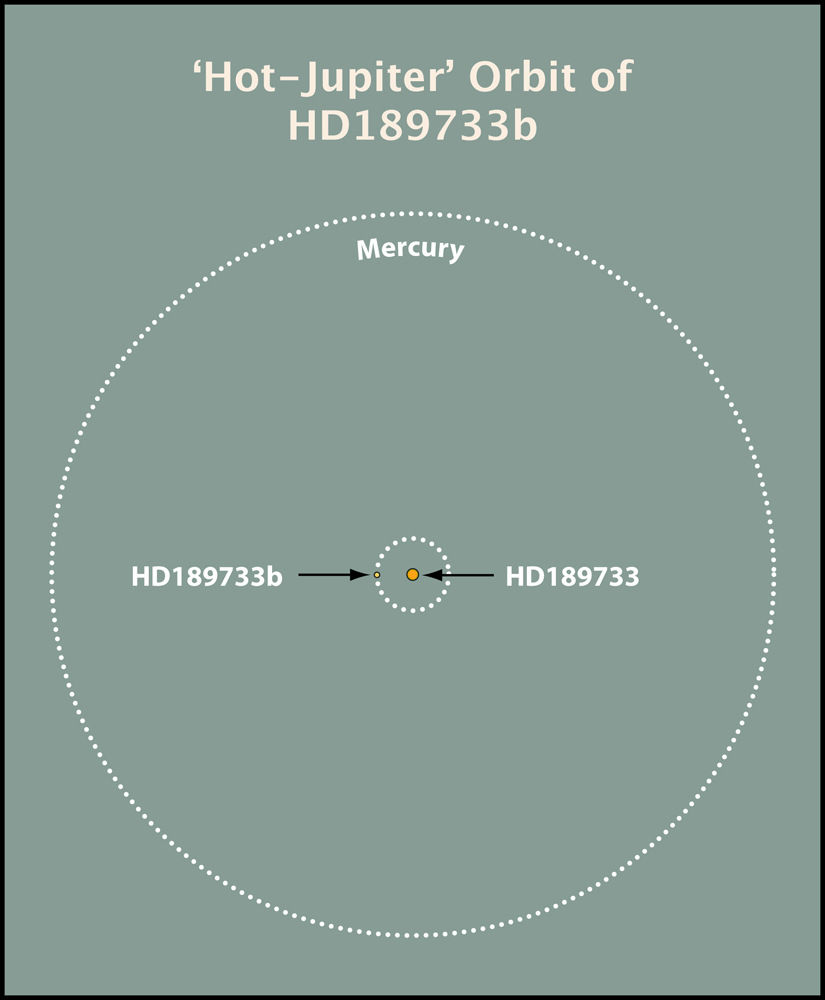Alien Planet's Evaporating Atmosphere Caused by Star Eruption

A Jupiter-size planet around a distant star has given astronomers a rare glimpse into the effects of space weather beyond our solar system: a view of an alien world unleashing an intense plume of gas triggered by an eruption from its parent star.
A team of astronomers used the Hubble Space Telescope to study the exoplanet HD 189733b, and noticed curious changes in the planet's upper atmosphere after it was bombarded with intense X-ray radiation from a flare unleashed by its host star.
From observations made in 2011, the researchers saw signs that the planet's atmosphere was evaporating, releasing strong bursts of gas at a staggering rate of at least 984 tons per second, the researchers said. The study's findings offered an intriguing view of changing climates and space weather on alien planets outside our solar system.
"We hadn't just confirmed that some planets' atmosphere evaporate, we had watched the physical conditions in the evaporating atmosphere vary over time," study leader Alain Lecavelier des Etangs, of the National Center for Scientific Research in France, said in a statement. "Nobody had done that before."
A hot, hot world
HD 189733b is a gas giant planet similar to Jupiter, but orbits extremely close to its star, just one-thirtieth of the distance between Earth and the sun. While the parent star, named HD 189733A, is slightly smaller and cooler than the sun, the climate of the alien world is still exceptionally hot, with temperatures above 1,830 degrees Fahrenheit (1,000 degrees Celsius). [The Strangest Alien Planets]
The exoplanet's close proximity to its star also means its upper atmosphere is constantly battered by energetic extreme-ultraviolet and X-ray radiation. According to the researchers, this makes HD 189733b a fascinating place to study how stellar activity affects an alien planet's atmosphere.
Breaking space news, the latest updates on rocket launches, skywatching events and more!
Lecavelier and his colleagues studied the atmosphere of HD 189733b during two periods in early 2010 and late 2011, as the planet crossed in front of its parent star and created a silhouette.
This natural backlighting enables astronomers to detect the chemical signatures of the planet's atmosphere on the starlight. Essentially, this process helps scientists read the chemical fingerprint of a planet's atmosphere when it is too far away to image directly.
The astronomers were keen to confirm results from a 2004 study of a different exoplanet, called HD 209458b. In that previous study, oxygen and carbon was seen evaporating off the planet at an immense rate.
But for this new study, it took more than just one look.
"The first set of observations were actually disappointing, since they showed no trace of the planet's atmosphere at all," Lecavelier said. "We only realized we had chanced upon something more interesting when the second set of observations came in."
It came from the star
Seeing the plumes of gas prompted the astronomers to delve into what caused the drastic change in the planet's upper atmosphere. Despite HD 189733b's extreme climate, the atmosphere alone is not hot enough to evaporate at such a staggering rate, the researchers said.
Rather, the evaporation is thought to be caused by powerful doses of X-ray and extreme-ultraviolet radiation from the parent star. Based on their calculations, the star's eruptions are 20 times more powerful than those on the sun, and HD 189733b likely receives 3 million times more X-ray radiation than Earth.
These suspicions were confirmed by observations from the Swift satellite, which can observe X-ray radiation from stars. A few hours before Hubble observed HD 189733b in 2011, Swift recorded a powerful flash of radiation exploding from the star, briefly making it four times brighter in X-ray light, the researchers said.
"X-ray emissions are a small part of the star's total output, but it is the part that is energetic enough to drive the evaporation of the atmosphere," study co-author Peter Wheatley, of the University of Warwick in the U.K., said in a statement. "This was the brightest X-ray flare from HD 189733A of several observed to date, and it seems very likely that the impact of this flare on the planet drove the evaporation seen a few hours later with Hubble."
X-rays can heat the gas in a planet's upper atmosphere to tens of thousands of degrees, which is hot enough to escape the gravitational pull of a giant planet, the researchers said. When the sun releases solar flares and coronal mass ejections, a similar but less intense process occurs in the Earth's upper atmosphere.
But, there are other possible explanations for the vaporization seen on HD 189733b.
For instance, what was observed between 2010 and 2011 may have been a typical uptick in the star's activity, similar to our own sun's roughly 11-year solar cycle.
Still, the astronomers are hoping to perform more follow-up observations using Hubble and the European Space Agency's XMM-Newton X-ray space telescope.
Follow SPACE.com on Twitter @Spacedotcom. We're also on Facebook and Google+.

Space.com is the premier source of space exploration, innovation and astronomy news, chronicling (and celebrating) humanity's ongoing expansion across the final frontier. Originally founded in 1999, Space.com is, and always has been, the passion of writers and editors who are space fans and also trained journalists. Our current news team consists of Editor-in-Chief Tariq Malik; Editor Hanneke Weitering, Senior Space Writer Mike Wall; Senior Writer Meghan Bartels; Senior Writer Chelsea Gohd, Senior Writer Tereza Pultarova and Staff Writer Alexander Cox, focusing on e-commerce. Senior Producer Steve Spaleta oversees our space videos, with Diana Whitcroft as our Social Media Editor.

